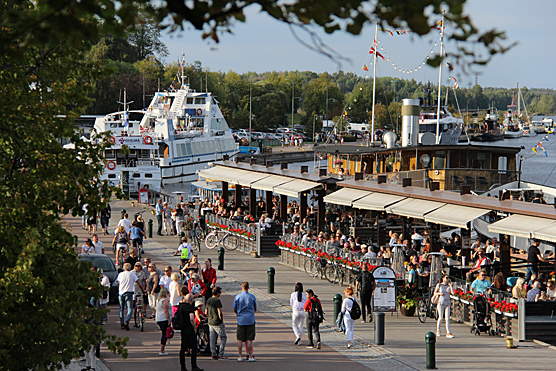
© City of Lappeenranta
The Canemure project is part of the long-term climate strategy of the South Karelia region and the City of Lappeenranta as well as their goal of becoming role models in climate-wise operations.
By the year 2030, both the City of Lappeenranta and the South Karelia region aim to reduce their emissions by 80% from the level recorded in 2007. Practical measures are used to quickly and efficiently reduce emissions.
The heat accumulator project of the City of Lappeenranta is based on a solution by a company called Elstor where carbon dioxide-free electricity is stored when the electricity is affordable. The energy stored in the accumulator is released into the district heating network to heat property and service water.
Hundreds of tonnes of emissions reduced
The heat accumulator was placed in the district heating plant of Mustola in June and its test run started at the end of the summer. Until now, the Mustola plant has used natural gas and fuel oil.
“The heat accumulator takes two to eight hours to charge, depending on its usage” says Product Development Engineer Aleksi Porkola from Elstor.
The heat accumulator may reduce the carbon dioxide emissions of Mustola’s district heating network by up to 480 tonnes each year. In 2017, the South Karelia region produced 864,000 tonnes of carbon dioxide emissions.
“We want to support innovation promoting energy efficiency in our region and participate in pilot projects,” says Climate Coordinator Petri Kero from the City of Lappeenranta.
The total cost of the Lappeenranta heat accumulator project is slightly over EUR 500,000 with 50% covered by funding from the LIFE programme of the EU.
Long canal locks prevent increase in emissions
South Karelia is well-prepared to act as a pioneer in reducing emissions as 88% of its residents live in Hinku municipalities (‘Towards Carbon Neutral Municipalities’ network). Of all the electricity produced in the region, 85% comes from renewable sources of energy. The Hinku municipalities are committed reduce their carbon dioxide emissions by 80% by 2035.
Projects in South Karelia include the development of biofuels and synthetic fuels, investing in carbon sinks in the countryside, highlighting the significance of railway traffic and aiming to extend the locks in the Saimaa Canal.
“The renewal of the vessel stock calls for longer locks. If the canal is not modernised, the worst case scenario is that the traffic in the canal abandons ships in favour of trucks, which means farewell to any emission reduction targets,” says Environmental Manager Matti Vaittinen from the Regional Council of South Karelia.
The region promotes public green procurement and better observation of environmental and emissions targets in zoning. Tools and indicators are currently being built for both goals.
“At the grass-roots level, the important thing is to inspire the citizens to be committed to our shared climate targets. We can see a clear shift in attitudes. Energy-efficient and low-emissions housing is one of the most tangible subsections of these efforts,” says Vaittinen.
Pioneer’s advantage
South Karelia is working on a regional roadmap for carbon neutrality. An important step on the roadmap was becoming the first Hinku region alongside Pirkanmaa to aim for carbon neutrality last autumn.
“In five workshops, we developed as list of about 200 measures, 80 of which were selected for the roadmap draft and for municipal evaluations during the summer of 2020,” says Kero.
South Karelia and Lappeenranta are motivated towards carbon neutrality for the same reasons.
“Emissions have to be reduced, and it’s a good idea to be a pioneer in this work. It improves the vitality of both the city and the region. Pure technology plays a huge role here. New operators are constantly arising from LUT University.”
Citizens are activated, for example, by searching for volunteer families to join a study where they can find means to reduce their carbon footprint.
Author: Jukka Nortio
The article was published in the Hiilineutraali Suomi journal in September 2020 (in Finnish).
Read more